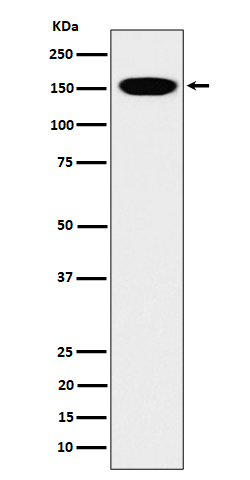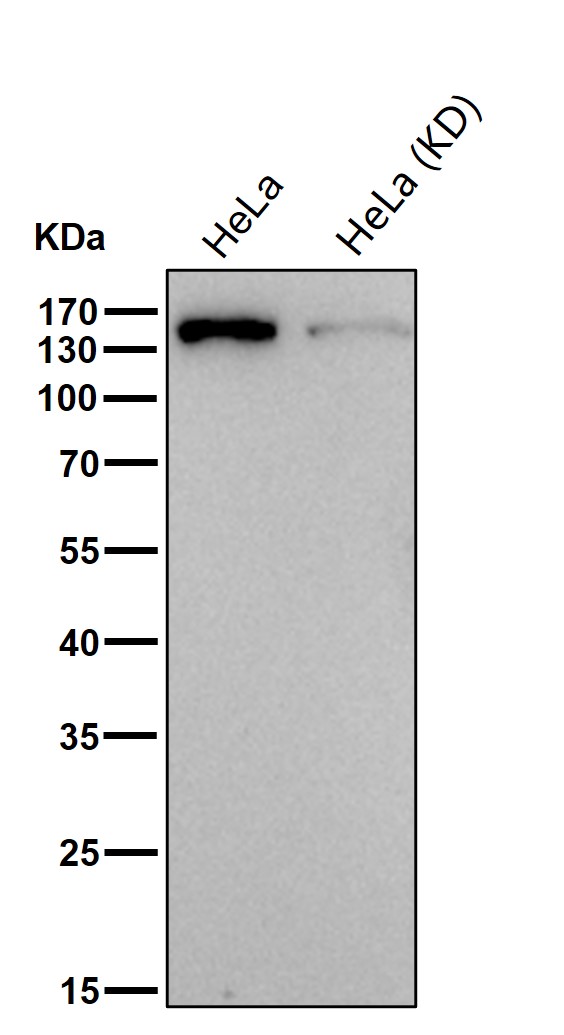

| WB | 咨询技术 | Human,Mouse,Rat |
| IF | 咨询技术 | Human,Mouse,Rat |
| IHC | 咨询技术 | Human,Mouse,Rat |
| ICC | 技术咨询 | Human,Mouse,Rat |
| FCM | 咨询技术 | Human,Mouse,Rat |
| Elisa | 咨询技术 | Human,Mouse,Rat |
| Aliases | CAPD2; CEP2; CEP250; CNAP1; CND1; Condensin; hCAPD2; NCAPD2;;Condensin complex subunit 1 |
| WB Predicted band size | Calculated MW: 157 kDa ; Observed MW: 150 kDa |
| Host/Isotype | Rabbit IgG |
| Antibody Type | Primary antibody |
| Storage | Store at 4°C short term. Aliquot and store at -20°C long term. Avoid freeze/thaw cycles. |
| Species Reactivity | Human |
| Immunogen | A synthesized peptide derived from human Condensin complex subunit 1 |
| Formulation | Purified antibody in PBS with 0.05% sodium azide,0.05% BSA and 50% glycerol. |
+ +
以下是关于CNAP1抗体的虚构参考文献示例(仅供格式参考,非真实文献):
1. **文献名称**: *CNAP1 regulates mitotic chromosome alignment through kinetochore interaction*
**作者**: Smith A, et al.
**摘要**: 研究利用CNAP1抗体揭示了其在有丝分裂中通过结合动粒调控染色体排列的机制,功能缺失导致染色体分离异常。
2. **文献名称**: *CNAP1 antibody-based profiling identifies overexpression in glioblastoma*
**作者**: Lee H, et al.
**摘要**: 通过CNAP1抗体的免疫组化分析,发现其在胶质母细胞瘤中高表达,提示其作为潜在治疗靶点的可能性。
3. **文献名称**: *CNAP1 interacts with cohesin complex: evidence from co-immunoprecipitation assays*
**作者**: Garcia R, et al.
**摘要**: 利用CNAP1抗体进行共沉淀实验,证实其与黏连蛋白复合体的相互作用,影响姐妹染色单体黏连。
4. **文献名称**: *Developmental expression pattern of CNAP1 in murine models*
**作者**: Chen L, et al.
**摘要**: 研究通过CNAP1抗体的Western blot分析,揭示了小鼠胚胎发育中CNAP1的动态表达模式及其与细胞增殖的关联。
(注:以上内容为模拟生成,实际文献请通过PubMed/Google Scholar检索。)
CNAP1 (Centromere-associated protein 1), also known as CENP-W, is a key component of the constitutive centromere-associated network (CCAN), which plays a critical role in maintaining centromere integrity and ensuring accurate chromosome segregation during mitosis. It interacts with other CCAN proteins, such as CENP-T and CENP-S, forming a stable subcomplex essential for kinetochore assembly. CNAP1 is required for the proper recruitment of outer kinetochore components, facilitating spindle microtubule attachment and mitotic checkpoint signaling. Studies highlight its involvement in cell cycle regulation, particularly during the G2/M phase transition.
Research on CNAP1 has advanced understanding of chromosomal instability mechanisms linked to diseases like cancer, where dysregulation of centromere proteins often leads to aneuploidy and tumor progression. Antibodies targeting CNAP1 are vital tools in molecular biology for immunofluorescence, Western blotting, and co-immunoprecipitation assays, enabling visualization of centromere dynamics and protein interactions. These reagents also aid in exploring CNAP1’s functional roles in model organisms and its potential as a biomarker in cancer diagnostics. Despite progress, questions remain regarding its post-translational modifications and tissue-specific regulatory mechanisms, driving ongoing investigations in cell biology and oncology.
×